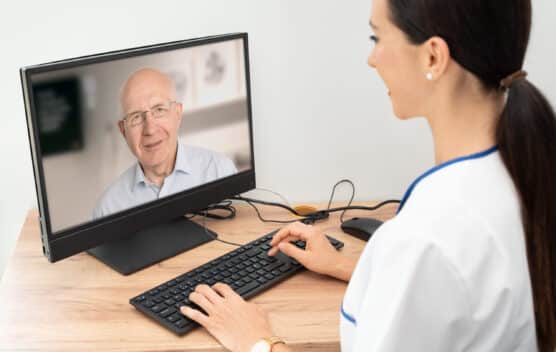Dr. Justin McArthur, director of Johns Hopkins University’s Department of Neurology (and President, American Neurological Association) described in a recent column for US News & World Report how the COVID-19 public health emergency is driving unprecedented adoption of telemedicine for neurology. He describes both how physicians might adapt their clinical care practices via telehealth, and research scientists their clinical trials.
Notable Benefits of Telemedicine for Neurology Care
In his piece, Dr. Martin describes a number of trends and benefits of offering neurological care via telemedicine. Five of those benefits include:
1. More Frequent Checkups
More frequent virtual check-ins (brief communication via technology-based services) — which improve overall outcomes for chronic conditions — are more attainable: applications of teleneurology include acute care, outpatient teleneurology, and teleconsultations.
Additionally, telemedicine gives providers the ability to conduct remote cognitive assessments and in-home visits, eliminating the need for commutes to far-away clinics. With telemedicine visits, neurologists can also observe home environments and easily conduct an analysis of potential safety hazards and make recommendations.
2. Increased Access
Teleneurology e-visits can improve access, reduce costs and potentially improve health outcomes, especially for patients in locations with a limited number of neurology practices. Data from 2017 projected significant neurologist shortages in states such as Wyoming, Alaska, North Dakota, South Carolina, South Dakota, and Oklahoma.
3. Managing Medication
Doctors can continue to see established patients, manage and adjust prescribed medications, assess treatment response, and order diagnostic tests. The lockdowns that have prevented on-site visits have shown that remotely conducted medication management has the potential to improve outcomes for a variety of conditions.
4. Reduced Exposure
Patients can receive coordinated care and a treatment plan in a safe, convenient manner. Even before the COVID-19 crisis, some patients had to risk exposure during annual flu season to maintain their health regimens. With telehealth, patients and their doctors remain connected, no matter their locations.
5. Speed in Emergencies
Technology used in some telemedicine programs allows physicians to reach patients in a local emergency room, providing the highest level of stroke expertise immediately from across state lines: every second counts during a stroke (“time is brain”), and access to clinical expertise for assessment and incident response can mean the difference in preventing permanent disability — or death.
Challenges to Overcome
While there are many benefits to neurologists who adopt telemedicine as part of their practices, several systemic challenges remain. Dr. Martin outlined a few key challenges around that medical and bureaucratic communities will need to address:
1. Regulatory hurdles
HHS has temporarily allowed the use of HIPAA non-compliant web and video conferencing platforms. The ubiquity of these technologies has removed one of the biggest barriers to telehealth deployment, but only for now. If this deregulation becomes permanent or if consumer-grade platforms work toward becoming HIPAA compliant, the potential for telehealth adoption would be vastly increased.
2. Disproportionate impact
Telemedicine is, of course, dependent on modern internet speeds and devices. To ensure broad and ready access to both, significant investment in high-speed access both in rural and in disenfranchised low-income urban areas will be necessary. Other solutions might include community centers with dedicated digital health-services access venues, such as libraries or public municipal buildings. The FCC has already announced investment plans to address parts of this challenge.
3. State limits
Physicians currently need to be licensed in the states where patients are located at the time of a telemedicine e-visit. Following the pandemic, enacting either a national licensing practice or removing state-to-state practice barriers will allow for further adoption.
Digital Tools Can Support Telemedicine Neurology
These temporary changes have already changed the direction of healthcare.
Most health care advances take five to 10 years to attain widespread adoption past the early adoption stage; Dr. Martin’s practice scaled up from ~10 teleneurology visits weekly (before COVID-19) to conducting 95% of visits with these platforms — in six weeks.
The ability to scale up during an emergency shows that even greater things are possible once the crisis has passed and more resources can be devoted to development.
Innovative solutions, including BrainCheck and its remote cognitive testing support, have supported the rapid adoption of telemedicine by helping clinicians assess cognitive health and provide continuous care remotely.
BrainCheck’s rapid, reimbursable, mobile testing can aid in the early detection of cognitive impairment. The platform also helps clinicians create cognitive care plans that improve outcomes. And expanded access to telemedicine means that neurologists and other physicians can provide these benefits to more patients, more efficiently.
Patients and practices alike stand to benefit from increased adoption of telemedicine for neurology. And while there are still challenges to overcome, BrainCheck is built to meet and exceed standards of care — now and in the future.
